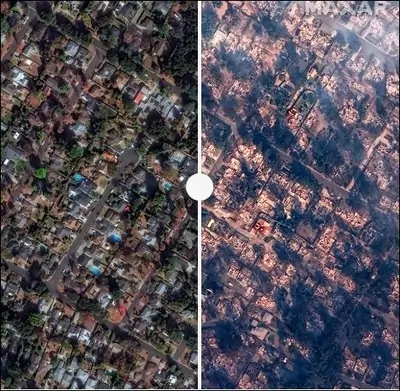
Table of Contents
Overview of the Homes Destroyed in Massive LA Wildfires
The devastating wildfires in Los Angeles during January 2025 have caused unprecedented destruction, affecting both urban and rural areas on an immense scale. Over 5,300 Homes Destroyed in Massive LA Wildfires, leaving tens of thousands of residents displaced, many of whom have lost everything.
The fires, fueled by a combination of fierce winds, prolonged drought, and extremely dry vegetation, have resulted in billions of dollars in damages in Homes Destroyed in Massive LA Wildfires. The loss of property, infrastructure, and natural resources is compounded by the environmental impact, with large areas of forested land, wildlife habitats, and agricultural zones severely impacted.
This event has been one of the most catastrophic in the city’s history, surpassing previous wildfire disasters in terms of scale and severity.
Firefighters, emergency responders, and local authorities have been working around the clock to contain the blazes and protect vulnerable areas, often under dangerous conditions. In addition to combatting the fires, teams have been involved in extensive evacuation efforts, providing shelter, medical assistance, and essential services to displaced individuals and families.
As the fires continue to threaten the region, authorities are focusing on protecting key infrastructure, such as power lines, hospitals, and transportation routes, while also preparing for long-term recovery. In addition to direct firefighting efforts, local, state, and federal agencies, including FEMA, have mobilized resources to support recovery, offering temporary housing, financial aid, and assistance for rebuilding.
The full impact of these fires is still unfolding, and recovery efforts will take months, if not years, to fully restore affected communities.
However, the outpouring of support from volunteers, relief organizations, and neighbouring communities provides hope for recovery, as residents and responders work together to rebuild and heal from this devastating disaster, it cause Homes Destroyed in Massive LA Wildfires.
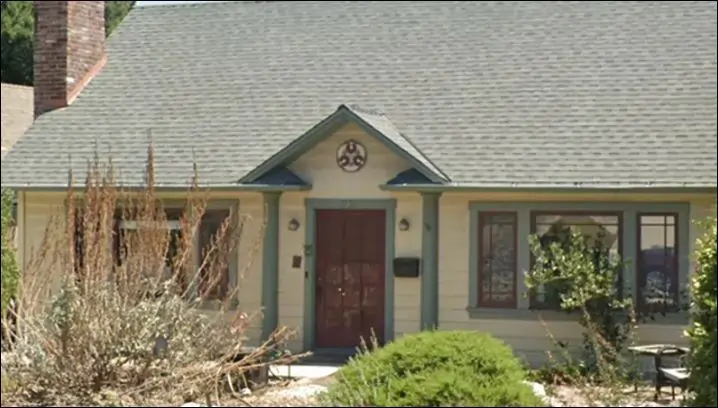
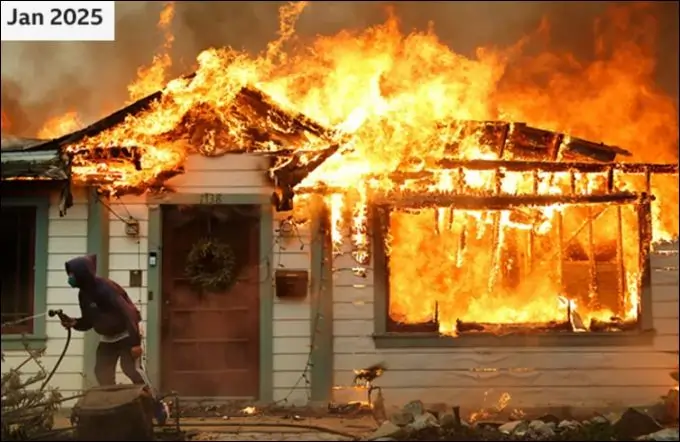
Impact on Communities
The destruction caused by the wildfires has been profound, with entire neighborhoods and communities reduced to ashes. Families have not only lost their homes but also irreplaceable belongings, photographs, and cherished memories, deepening the emotional toll of the disaster.
In addition to residential areas, vital infrastructure such as schools, businesses, roads, and power lines has sustained significant damage. The fires have left large portions of the region without electricity, clean water, or functioning communication networks, further complicating recovery efforts.
An estimated 25,000 residents have been displaced and included in Homes Destroyed in Massive LA Wildfires, with many seeking refuge in evacuation centers and emergency shelters.
These centers are providing essential support, including food, water, medical assistance, and temporary housing, but the scale of displacement has strained local resources. The need for long-term housing solutions and mental health support is expected to grow as the recovery process progresses.
The local economy has taken a major hit, particularly in areas reliant on small businesses and agriculture. Farms, vineyards, and local enterprises have suffered extensive damage, leading to lost income, jobs, and critical supplies. The impact on the workforce, combined with the widespread destruction of commercial properties, will likely have a ripple effect across regional and state economies in the coming months.
Emotional trauma has become another pressing concern, as many residents face the uncertainty of rebuilding their lives after losing everything. The psychological effects of displacement, loss, and the ongoing uncertainty of when they can return to their homes are taking a heavy toll on individuals and families.
Mental health professionals, local support groups, and community organizations are working to provide counseling, trauma recovery services, and assistance to help residents cope with the long-term emotional impact of the disaster.
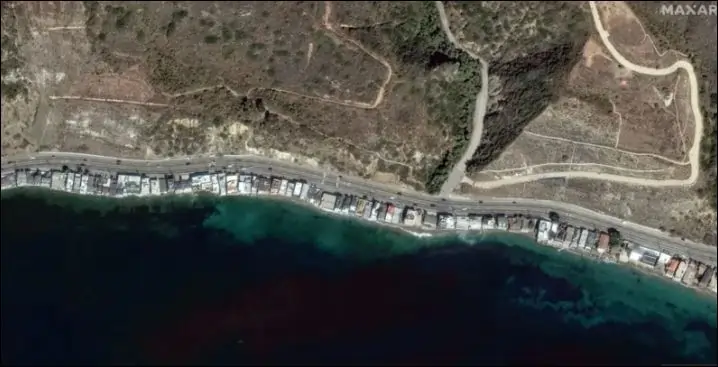
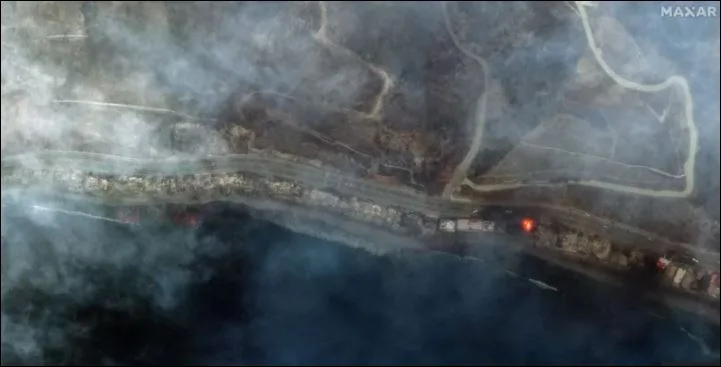
Emergency Response and Support Efforts
Authorities have declared a state of emergency in response to the scale and severity of the wildfires, enabling the mobilization of resources from local, state, and federal agencies. Firefighting crews, supported by helicopters, water-dropping aircraft, and specialized ground units, have been working tirelessly around the clock to contain the fires and protect vulnerable areas.
Despite the challenging conditions, including extreme heat and rapidly shifting winds, these teams have made significant progress in controlling the blazes, although several areas remain at high risk of flare-ups.

Relief organizations, including the American Red Cross, have quickly set up emergency shelters in multiple locations, providing displaced residents with food, water, and medical assistance.
In addition to immediate relief, these organizations are coordinating donation drives to collect funds, non-perishable food, clothing, and other essential supplies for those affected. The generosity of donors has been crucial in supporting these ongoing relief efforts.
The Federal Emergency Management Agency (FEMA) has activated a range of disaster recovery programs to assist displaced families. These programs include providing temporary housing assistance, financial aid for home repairs, and grants to cover essential living expenses.
FEMA has also collaborated with local governments to assess the damage and prioritize recovery efforts, such as clearing debris and restoring essential infrastructure like roads, utilities, and emergency services.
In addition to FEMA’s efforts, local volunteers, community organizations, and nonprofit groups have played a critical role in providing supplies, offering shelter, and offering emotional support to survivors. These organizations are focused on long-term recovery, providing not just material assistance, but also mental health services to help residents cope with the trauma and uncertainty caused by the disaster.
The coordinated efforts of governmental agencies, relief organizations, and local volunteers are essential to helping the region recover and rebuild in the aftermath of this catastrophic event.
Causes Behind the Wildfires

The wildfires were fuelled by a combination of natural and human factors, resulting in one of the most destructive fire seasons in California’s history. Prolonged drought conditions, exacerbated by the effects of climate change, created an environment of extremely dry vegetation, effectively turning the region into a tinderbox.
These drought conditions have been intensified over recent years due to shifting weather patterns, higher temperatures, and below-average rainfall, all of which contribute to the increasing vulnerability of California’s landscape to wildfires.
Strong Santa Ana winds, which are common in the region during the fall and winter months, played a key role in fanning the flames, allowing the fires to spread rapidly across vast areas of dry brush and forest. These winds, which can reach speeds of up to 60 miles per hour, create extremely dangerous conditions for both residents and first responders, pushing the fires into populated areas with little warning.
In addition to natural factors, human activities may have contributed to the ignition of the wildfires. While investigations into the exact causes are ongoing, there are concerns that illegal campfires, discarded cigarettes, power lines, and malfunctioning electrical equipment may have sparked the initial flames in some instances. It’s also possible that deliberate acts of arson may have played a role in certain areas.

Experts warn that rising global temperatures are increasing both the frequency and intensity of such disasters. As climate change accelerates, California and other wildfire-prone regions are seeing longer fire seasons, with higher temperatures, stronger winds, and less moisture creating ideal conditions for wildfires to spread uncontrollably.
Given these trends, experts stress the need for proactive measures, including better forest management, improved firebreaks, stricter building codes, and enhanced early warning systems to reduce the risk and mitigate the impacts of future wildfires. Public education and greater investment in climate resilience are also essential to adapting to this growing threat.
Preventive Measures for Wildfire Safety
Residents in wildfire-prone areas are encouraged to take precautions to protect their homes and families. Key measures include:
- Creating defensible spaces by clearing brush and debris around homes.
- Installing fire-resistant roofing and siding materials.
- Preparing “go bags” with essentials like water, medication, and important documents.
- Staying informed through emergency alerts and evacuation orders.
Community-wide efforts, such as better land management practices and investing in advanced firefighting technologies, are also essential in reducing wildfire risks.
Conclusion
The “Homes Destroyed in Massive LA Wildfires” have highlighted the profound and far-reaching impacts of natural disasters, with over 5,300 homes destroyed and thousands of lives disrupted across the region. In addition to the tragic loss of Homes Destroyed in Massive LA Wildfires have resulted in significant environmental damage, including the destruction of vast areas of forested land, wildlife habitats, and infrastructure.
Despite the magnitude of the disaster, the resilience shown by the affected communities, along with the coordinated response from local, state, and federal agencies, as well as countless volunteers and organizations, offers a ray of hope for recovery.
Relief efforts have focused on providing immediate assistance to those displaced, with long-term recovery strategies also in place to rebuild homes, restore infrastructure, and support affected individuals and families.
This tragedy underscores the critical need for proactive disaster preparedness, including early warning systems, robust firebreaks, and improved evacuation plans. It also serves as a powerful reminder of the importance of adopting sustainable land management practices, such as controlled burns and defensible space, to reduce the risk of future wildfires.
Finally, the events emphasize the need for collaborative efforts among governments, organizations, and communities to address climate change and environmental degradation, which are contributing to the increasing frequency and intensity of such disasters. These lessons are vital for mitigating future risks and enhancing resilience in the face of growing natural disaster threats.
FAQs
1. How many Homes Destroyed in Massive LA Wildfires?
Over 5,300 Homes Destroyed in Massive LA Wildfires, marking this disaster as one of the most destructive in the city’s history. The devastation extended beyond residential properties, impacting entire neighborhoods, displacing thousands of residents, and leaving a long-term scar on local communities.
The fires also caused significant damage to critical infrastructure, including power lines, roads, and communication networks, further complicating response and recovery efforts. In addition to the physical destruction, the environmental impact has been severe, with large areas of land, including forests, parks, and wildlife habitats, being consumed by the flames.
This widespread damage underscores the increasing threat posed by wildfires in urban and suburban areas, highlighting the urgent need for improved fire management strategies and disaster preparedness in fire-prone regions.
2. What caused the wildfires?
The fires were triggered by a combination of factors, including prolonged drought conditions, strong winds, dry vegetation, and the potential influence of human activities. The region had been experiencing an extended drought period, which significantly lowered soil moisture levels and made vegetation more susceptible to ignition.
The dry conditions were compounded by intense winds, which rapidly spread flames across large areas, overwhelming firefighting efforts. Additionally, dry vegetation, particularly during the peak fire season, provided ample fuel for the fires to intensify and spread quickly.
3. Are there financial assistance programs for affected residents?
Yes, FEMA (Federal Emergency Management Agency) and other organizations are actively providing a range of support to individuals, communities and Homes Destroyed in Massive LA Wildfires, including temporary housing, financial aid, and resources for rebuilding.
FEMA has been working to establish disaster recovery centers, where affected residents can access assistance for housing relocation, temporary shelters, and grants to cover essential expenses such as home repairs, medical bills, and daily living costs.
Financial aid programs, such as the Individuals and Households Program (IHP), are designed to help survivors recover from the immediate financial burdens caused by the destruction of their homes.
Furthermore, FEMA has been collaborating with state and local authorities to facilitate the rebuilding of infrastructure and homes, with a focus on strengthening resilience to future disasters. This includes offering low-interest loans for homeowners and businesses to repair or replace damaged property, as well as funding for public infrastructure repairs like roads and utilities.
These coordinated efforts aim to help affected communities recover that was been part of Over 5,300 Homes Destroyed in Massive LA Wildfires, and for them more quickly while also promoting long-term resilience and disaster preparedness.
4. How can I help those affected from their Homes Destroyed in Massive LA Wildfires?
You can make a meaningful difference by donating to organizations like the American Red Cross, volunteering at local shelters, or contributing essential supplies to support displaced residents.
The American Red Cross provides critical disaster relief, including shelter, food, and medical assistance, and relies on donations to fund these efforts. Monetary donations can help the organization respond quickly to the needs of affected individuals, while blood donations are also crucial during such crises..
For more reliable and up-to-date information on how to contribute, it’s recommended to check with official disaster relief organizations and local government websites. Ensuring that donations are made through reputable channels is critical to maximizing the impact of your support and helping affected communities recover more effectively.
5. What steps can be taken to prevent wildfires?
Preventing wildfires requires a multi-faceted approach that addresses both natural and human factors. While some wildfire risks are linked to climate patterns and natural conditions, there are several steps that can be taken to reduce the likelihood of wildfires and mitigate their impacts. These steps involve land management, building practices, public education, and governmental policies.
Improved Forest and Land Management
- Controlled Burns (Prescribed Fires): Conducting controlled burns in a controlled and safe manner can reduce the buildup of dry vegetation and dead trees that act as fuel for larger, uncontrolled fires. These burns mimic the natural fire cycles of ecosystems and help maintain healthy forests while reducing the severity of wildfires.
- Vegetation Clearing: Regularly clearing dry brush, dead trees, and other combustible materials from forests and wildland-urban interface areas (where homes and forests meet) reduces the amount of fuel available to a fire. This is especially important in high-risk areas.
- Creating Firebreaks: Firebreaks, or cleared areas devoid of vegetation, act as barriers to slow or stop the spread of wildfires. These can be strategically placed around communities, critical infrastructure, and sensitive ecosystems to reduce fire risks.
Building Codes and Design
- Fire-Resistant Building Materials: Constructing homes and buildings with fire-resistant materials, such as non-flammable roofing and siding, can help reduce the vulnerability of structures to wildfires. Installing spark arresters and fireproof windows can further enhance fire resistance.
- Defensible Space: Creating defensible space around homes and properties—an area where vegetation is cleared or maintained to prevent fire from reaching the structure—can help firefighters protect buildings more effectively. This includes trimming trees, mowing grass, and maintaining a safe distance between trees and structures.
Improved Public Awareness and Education
- Fire Safety Campaigns: Public education campaigns about fire safety, including how to properly dispose of campfires, safely use equipment, and avoid activities like burning trash on windy days, can help prevent human-caused fires. These campaigns can target residents, campers, and outdoor enthusiasts in high-risk areas.
- Emergency Preparedness: Educating communities on how to prepare for wildfires—such as creating evacuation plans, maintaining emergency kits, and understanding fire behavior—can save lives and help residents respond quickly in the event of a fire.
Stricter Regulations on Human Activities
- Regulating Campfires and Open Flames: Implementing and enforcing stricter regulations on campfires, barbecues, and other open flames during fire season can prevent accidental ignitions. This includes banning campfires in high-risk areas or when weather conditions (such as high winds) are dangerous.
- Power Line Maintenance: Ensuring that power lines are regularly inspected and maintained to prevent sparks caused by faulty lines or fallen branches is essential. In some cases, undergrounding power lines in high-risk areas can prevent fires caused by downed wires.
Government and Community Action
- Climate Action: Addressing the underlying factors contributing to rising temperatures and changing weather patterns through global climate action is key to reducing wildfire risks in the long term. Efforts to curb greenhouse gas emissions, protect forests, and invest in sustainable land management practices are critical for adapting to the increasing threat of wildfires.
- Firefighting Infrastructure: Investing in firefighting resources, such as better equipment, training, and personnel, as well as establishing early-warning systems, can improve response times and reduce the impact of wildfires when they do occur.
Monitoring and Early Detection
- Satellite and Drone Technology: Using satellite imagery, drones, and advanced sensors to monitor fire-prone areas and detect potential fires early can help authorities respond before fires escalate. These technologies allow for real-time data collection on fire behavior and weather patterns, helping firefighters plan more effective strategies.
- Community Monitoring Networks: Engaging local communities in monitoring their surroundings and reporting potential fire hazards or unusual activity can strengthen early detection systems. Communities can work together to reduce the risk of accidental fires by reporting illegal campfires or abandoned burning sites.
By implementing these strategies, communities can work to reduce the risk of wildfires, protect lives and property, and build resilience to the growing threat posed by climate change and wildfire activity.
Disclaimer
The information presented in this article: Over 5,300 Homes Destroyed in Massive LA Wildfires is based on data available as of January 2025. Given that wildfire impacts and recovery efforts are continuously evolving, the figures, statistics, and details mentioned may change as new information emerges.
For the most accurate, current, and comprehensive updates, it is strongly recommended to consult official sources, including local emergency services, the Federal Emergency Management Agency (FEMA), and the Los Angeles Fire Department.
These agencies provide real-time information and updates on the situation of the people that has been one of the Homes Destroyed in Massive LA Wildfires, response efforts, and safety measures in place.
TechWirings does not endorse or explicitly support any views or actions expressed in this content.










